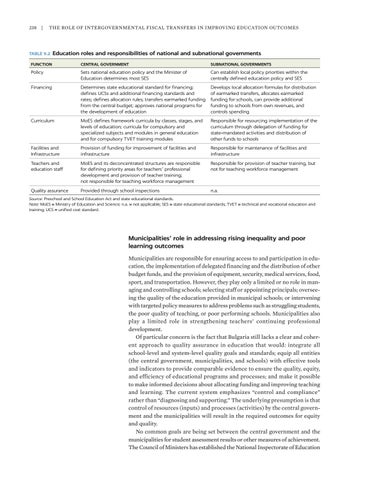238 | The Role of Intergovernmental Fiscal Transfers in Improving Education Outcomes
TABLE 9.2 Education
roles and responsibilities of national and subnational governments
FUNCTION
CENTRAL GOVERNMENT
SUBNATIONAL GOVERNMENTS
Policy
Sets national education policy and the Minister of Education determines most SES
Can establish local policy priorities within the centrally defined education policy and SES
Financing
Determines state educational standard for financing; defines UCSs and additional financing standards and rates; defines allocation rules; transfers earmarked funding from the central budget; approves national programs for the development of education
Develops local allocation formulas for distribution of earmarked transfers, allocates earmarked funding for schools, can provide additional funding to schools from own revenues, and controls spending
Curriculum
MoES defines framework curricula by classes, stages, and levels of education; curricula for compulsory and specialized subjects and modules in general education and for compulsory TVET training modules
Responsible for resourcing implementation of the curriculum through delegation of funding for state-mandated activities and distribution of other funds to schools
Facilities and Infrastructure
Provision of funding for improvement of facilities and infrastructure
Responsible for maintenance of facilities and infrastructure
Teachers and education staff
MoES and its deconcentrated structures are responsible for defining priority areas for teachers’ professional development and provision of teacher training; not responsible for teaching workforce management
Responsible for provision of teacher training, but not for teaching workforce management
Quality assurance
Provided through school inspections
n.a.
Source: Preschool and School Education Act and state educational standards. Note: MoES = Ministry of Education and Science; n.a. = not applicable; SES = state educational standards; TVET = technical and vocational education and training; UCS = unified cost standard.
Municipalities’ role in addressing rising inequality and poor learning outcomes Municipalities are responsible for ensuring access to and participation in education, the implementation of delegated financing and the distribution of other budget funds, and the provision of equipment, security, medical services, food, sport, and transportation. However, they play only a limited or no role in managing and controlling schools; selecting staff or appointing principals; overseeing the quality of the education provided in municipal schools; or intervening with targeted policy measures to address problems such as struggling students, the poor quality of teaching, or poor performing schools. Municipalities also play a limited role in strengthening teachers’ continuing professional development. Of particular concern is the fact that Bulgaria still lacks a clear and coherent approach to quality assurance in education that would: integrate all school-level and system-level quality goals and standards; equip all entities (the central government, municipalities, and schools) with effective tools and indicators to provide comparable evidence to ensure the quality, equity, and efficiency of educational programs and processes; and make it possible to make informed decisions about allocating funding and improving teaching and learning. The current system emphasizes “control and compliance” rather than “diagnosing and supporting.” The underlying presumption is that control of resources (inputs) and processes (activities) by the central government and the municipalities will result in the required outcomes for equity and quality. No common goals are being set between the central government and the municipalities for student assessment results or other measures of achievement. The Council of Ministers has established the National Inspectorate of Education






